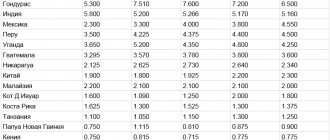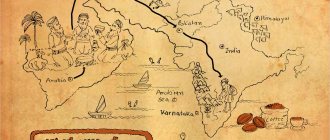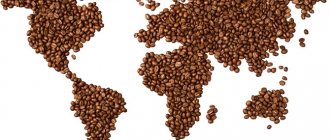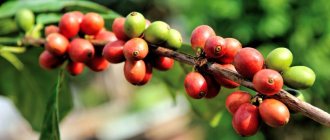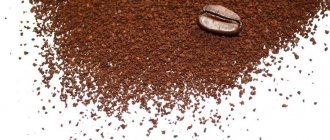In order for a coffee tree to grow and begin to bear fruit, you need to spend a lot of time and effort. In order to obtain a high-quality product, most of the steps are performed manually. In addition, attention is paid to the location of the plantations. Naturally, true connoisseurs of the aromatic drink want to know how coffee grows and in which countries the plant is grown.
Historical reference
People knew about the tonic and invigorating properties of the fruits of the coffee tree already in the 9th century. Then the berries were consumed raw, in pure form or with animal fat and milk.
Over time, people learned to prepare a tincture from the peel and pulp of the fruit. Coffee in its usual form from ground beans appeared in the 13th century.
Find out more in the article “What is coffee: the history and homeland of the aromatic drink.”
Who brought coffee to Russia?
Some sources mention that Peter I brought coffee to Russia. In 1697, he visited Holland, where he was pleasantly surprised by the unusual taste and aroma of the invigorating drink. Since 1718, coffee was served at all balls and important events, and already in 1740, the first coffee house working on the traditions of Western countries was founded in St. Petersburg.
There are other assumptions, since the Tale of Bygone Years talks about how Prince Vladimir Svyatoslavovich drank the thick drink. Moreover, the official date of the appearance of coffee in Russia is 1665. It is believed that the doctor prescribed Alexei Mikhailovich to drink a cup of the invigorating composition “to combat runny noses, headaches and arrogance.”
Varieties
There are 90 species of coffee trees from the madder family in the world. 20 of them bear fruits that are suitable for consumption. And people collect grains from only two species, which they supply to factories.
Arabica: an Arabian variety that grows in high mountain areas up to 2500 meters above sea level. It has a rich aroma. Despite difficulties in cultivation, coffee is the leader in exports - 60% of all types.
Robusta: Congolese variety, undemanding to living conditions. Contains twice as much caffeine as Arabica. Less aromatic, therefore less valuable. It makes up 20% of the total volume of coffee beans grown.
Other varieties: Arabusta, Liberica, Excelsa. Details in the article “Name and characteristics of coffee varieties.”
Popular producing countries: do they produce or not?
Türkiye
Türkiye is not climatically suitable for growing coffee trees. However, Turkish coffee is one of the most popular among lovers of this drink. When going to Turkey on vacation, tourists try to bring natural coffee from there, since the cost of beans there is several times less than the cost of the same beans in Russia.
the Kurukahveci Mehmet Efendi budget mixture is 4-7 dollars per 100 grams. And if you also bargain with the seller, you can buy it for less money.
Italy
Italy is considered the largest coffee producer, where in fact coffee trees do not even grow - the climate does not allow it. The country purchases large quantities of grain from countries that grow coffee, processes it and supplies it to the market in finished form as a producer.
Italians have learned to create amazing mixtures from coffee beans, which has won recognition all over the world.
The most popular Italian brand is Lavazza , which is very loved and appreciated even in Russia. Beans for this brand are purchased in Brazil, India, Vietnam and Colombia. The cost of such coffee is from 10 dollars per 100 grams.
Squisito coffee is mainly produced for coffee machines in special capsules. Raw materials for this brand are purchased from Ethiopia, Brazil and Kenya. Its price starts from $50 for 100 capsules.
Illy brand coffee, Italians use Arabica blends from all over the world, specially selecting different varieties that perfectly complement each other’s taste qualities. Price: from 10 dollars per 100 g.
Tunisia
Coffee is also not grown here, the conditions are not suitable. However, as a producer, Tunisia is well-known among middle-class coffee lovers, as the country supplies the market with inexpensive but high-quality coffee.
Bondin , costing from 5 dinars per 100 grams, is in great demand among tourists Tourists often purchase grains in specialized stores, less often in the market, since there is a high probability of purchasing a craft product.
The main suppliers of coffee are Vietnam, Brazil, Uganda and Kenya.
Armenia
In Armenia, coffee trees are not grown or even processed for export. However, this drink is highly revered in the country. No meeting is complete without a cup of coffee. What's the matter: the country of Armenia is confused with the city of the same name Armenia, which is located in Colombia. In the 19th century, Armenians settled in Colombia, who came there to work on plantations and lived in a small settlement, which a little later began to be called Armenia. Years passed, and this has already become the city of Armenia, which today houses the most famous coffee museum. Today, the Colombian city of Armenia is the center of the Colombian coffee trade. It is there that grains are grown and processed for export.
It is in Colombian Armenia that the best White coffee , which is in demand all over the world. The cost of this coffee starts from $50 per package.
Coffee belt
Optimal conditions
The homeland of coffee trees is Ethiopia and the territory of modern Yemen, which is located on the Arabian Peninsula. Here these plants grew wild.
The following climatic conditions are necessary for tree growth and fruit ripening:
- average annual air temperature – 20°С;
- precipitation amount – 1000-1800mm per year;
- Some trees require high altitudes.
Interesting! Is it possible to drink expired coffee?
These conditions correspond to a tropical climate. In other climatic zones, coffee trees are found as ornamental non-fruit-bearing plants. Whether coffee grows on mountain slopes or in valleys determines its taste and smell.
Belt coverage area
Regions that have suitable climatic conditions for growing coffee trees are located along the equator. They move away from it at 20° north and south latitude. The corridor, which is limited by these latitudes, encircles the planet. Hence the name coffee belt of the earth.
According to the world map, the belt covers the territories of South and Central America, Central Africa, Southeast Asia, Australia, New Zealand and the islands of Oceania. In total, there are 80 countries where coffee is grown. But only 50 of them are world exporters.
The turnover of coffee raw materials is 5 million tons per year. There are leaders in this market - coffee producing countries. The harvest is measured in bales, each containing 60 kg of green grains.
Let's look at which countries coffee is grown in.
The best coffee
Let's not beat around the bush: Geisha coffee is the best. Approximately 18% of samples of this variety scored 96-100 points on the Q-Grade scale. This variety outperforms other coffee tree varieties in all respects, having more specimens at the top of the list than at the bottom.
A couple of interesting finds:
- The Pacamara variety is sometimes compared to Geisha, but according to statistics, only 2.22% of samples of this variety managed to score the highest score. Kenyan coffees SL28 and SL34 performed much better, while Bourbon also fell flat at 2.38%.
- It is worth noting that the Typica variety has more quality problems compared to other varieties. Almost every fifth sample of the Typica variety scored less than 89 points. This is a poor result, even compared to the more common specialty coffees: Caturra, Catuai and Bourbon.
- I would like to pay more attention to the varieties of coffee trees - Ethiopian heritage. Although Ethiopian beans are commonly referred to as “heirloom” beans, scientists do not consider Ethiopia to be the sole origin of coffee.
Leaders in coffee growing
Brazil
A state on the South American continent with an equatorial or subequatorial humid climate that is suitable for growing coffee. The average annual temperature is within 18-28°C. Precipitation amount is 1500-3000 mm per year. This allows you to maintain gardens and achieve record harvests.
Brazil produces a third of the total world volume - up to 40 million bales per year. Arabica, Robusta, Serrato, Bourbon, Bahia and Santos are grown here. Brazilian grains are of low quality - farmers are chasing quantity.
There are 800 million coffee trees in the country. In 365 days, one yields up to 3.5 kg of grains.
Main importers: USA, Italy, Japan, CIS countries led by Russia. According to experts, the state exports only 30% of the harvest. The rest goes to the domestic market. On average, each Brazilian consumes 5 kg of grains per year.
Information on the topic is in the article “Which countries occupy the first places in coffee consumption.”
Colombia
In the south of Colombia, in the Andes, high-quality Arabica beans are grown. Robusta is not found here. Manufacturers focus on quality. Colombia's market share is impressive - up to 9%, which is equal to 10 million bales. Such indicators allow the state to be one of the three largest global producers.
Interesting! Can mothers drink coffee while breastfeeding?
Varieties: Colombia Supremo, Supremo Medellin, Excelso, Bogota. The main exports are to the USA, Germany, France, Italy and Japan.
Indonesia
A state located on the islands of the Malay Archipelago in the Pacific Ocean. Specializes in growing high quality Arabica beans.
Coffee production here was started by Europeans back in the 17th century, and the Java, Sumatra, and Sulawesi varieties are still considered elite. Indonesia produces robusta - up to 9 million bales per year.
Vietnam
Coffee trees were brought to Vietnam in the second half of the 19th century and the industry did not develop until the 1980s.
At the end of the last century, Vietnam began to increase production at an accelerated pace. It has become a world leader and is currently second only to Brazil in terms of volume.
However, Vietnam is the only one that specializes in growing exclusively robusta. The Vietnamese market share is 18% of the total global volume.
Mexico
In the south of Mexico, more than 100,000 farmers cultivate Arabica varieties: Altura, Pluma, Liquidambar MS. Mexican exporters supply up to 6 million bales per year to the foreign market.
Ethiopia
The list of leaders in coffee production on the African continent is headed by Ethiopia, the birthplace of the coffee tree. Here it is possible to grow up to 4 million bales of dry grains in a good year, which is equal to 5% of the world market share.
The Sidamo variety, which is grown in the vicinity of the city of Kaffa, is rightfully considered one of the best in the world. In addition, Arabica varieties Harar and Yirgachif are produced. A quarter of the population is engaged in plantation cultivation.
India
India produces up to 3.8 million bales of premium Arabica coffee. There is an “Indian Coffee Council” in the country, which monitors the quality of the beans collected.
The technology of dry drying of raw materials gives the Indian product a delicious, unique taste. Famous varieties are Monsoon Malabar and Mysore.
Guatemala
Another American state included in the top 10 largest producers. Guatemala produces grains of the elite Huetenango and Atitlan varieties. Harvests reach 3.5 million bales per year.
Ivory Coast
At the end of the 90s, this African state received 0.9 million bales more than now. The sharp decline is associated with low-quality raw materials. To grow a lot of expensive product, planters switched to robusta. About 3.3 million bales enter the world market from Côte d'Ivoire.
Interesting! Which countries rank first in coffee consumption?
Uganda
Uganda closes the list of countries supplying grains to the world market. This small country in Africa offers robusta, although Arabica also grows there.
This is the only economic sector and almost the entire working population is employed on plantations. The average annual harvest reaches 3 million bales.
Traditions and customs associated with coffee and the coffee tree
Since the history of the emergence and development of coffee culture has been going on for several hundred years, unique traditions and customs are associated with the coffee tree and the drink obtained from its beans in many countries. We will tell you about some:
- In Ethiopia, a guest who comes to the house is treated to coffee. In this case, the owner of the home must brew the drink, and in his absence, the eldest son. The guest cannot refuse the treat - this is considered an insult to all family members.
- In Iraq, it is considered indecent to drink more than three cups of drink a day - such excess is condemned by society and is considered a sign of addiction.
- Japan did not recognize the drink for a long time, since the tea tradition is strong in this country. Now you can drink a cup of espresso or cappuccino in any cafe, but residents of the country to this day do not like strong varieties, preferring soft roasting.
- In Turkey, for several centuries, a girl’s ability to conduct a coffee ceremony according to all the rules was considered one of her most important advantages at the brides’ fair.
Other regions
Introduction
These are not all coffee producing countries and states in the world.
There are states where planters focus on growing the best coffee. Some varieties are not sold to other states. You can buy them in places where they are cultivated.
There are countries that, like Brazil, do not strive for quality. They did not have enough place in the leading list. But this does not mean that they are not full-fledged participants in the world’s coffee market.
Central and South America
In these territories, grains are grown in large quantities in another 21 regions:
- Jamaica;
- Panama;
- Nicaragua;
- Haiti;
- Belize;
- Honduras;
- Cuba;
- Dominican Republic;
- Costa Rica;
- El Salvador;
- Puerto Rico;
- Guyana;
- Venezuela;
- Bolivia;
- Ecuador;
- Paraguay;
- Guiana;
- Peru;
- Suriname;
- Trinidad;
- Tobago.
They supply half of the volume of raw materials to the world market. Planters rely on quality and grow Arabica beans.
Africa
Another 11 African regions export products to other countries:
- Angola;
- Tanzania;
- Zambia;
- SOUTH AFRICA;
- Madagascar;
- Zimbabwe;
- Botswana;
- Congo;
- Cameroon;
- Kenya;
- Saint Helena Island.
African farmers are the only ones in the world who offer rare varieties: Liberica, Cameroon, Excelsa.
